In the last decade, cybersecurity has come a long way. Once upon a time, keeping your IT environment secure largely required passwords, firewalls, and antivirus.
In the days since, the move to cloud technology has thrown up a whole range of advanced tools and defenses to protect organizations that have employees and data distributed around the world.
Unified endpoint management (UEM) is just one of these products. Today, it’s becoming an increasingly popular way to keep your IT environment safe in a distributed, cloud-based world. In this blog, we explain how UEM works and compare the leading solutions. Here’s what we discuss:
- What is UEM and what features does it include?
- What are the pros and cons of the best unified endpoint management tools?
- What do reviewers say about the leading UEM vendors?
What Is Unified Endpoint Management – And Why Do You Need It?
In the world of endpoint management alone, the last decade has thrown up a whole smorgasbord of new terms, including mobile device management (MDM), mobile application management (MAM), and enterprise mobility management (EMM). Apart from being confusing, it also makes it difficult for organizations to understand which solution they need and how to get it.
Unified endpoint management is, on the surface, just another acronym to add to the list. But in truth, it’s actually designed to make this confusing and overlapping mess of different solutions a little simpler. The goal is to consolidate three different types of cybersecurity products that have developed over the last decade:
- Mobile device management – This was developed to allow IT teams to remotely manage and monitor company-owned mobile devices. It gives admins total control, including the ability to provision, enroll, and encrypt devices. These features allow security teams to remotely install apps and lock or wipe a device.
- Mobile application management – MDM is great, but it only works if the company owns the device. When the bring-your-own-device (BYOD) revolution arrived, employees felt (understandably) cautious about giving IT admins complete control over their personal devices. Instead, MAM gave IT admins the ability to manage specific apps. This is generally done through ‘containerization’ – which creates a virtual barrier between personal and company-managed apps on a single device.
- Enterprise mobility management – By this point, the market had made good progress. But ultimately, MAM and MAM are good solutions for managing mobile devices – not a unified approach to managing everything. EMM takes a step in the right direction by adding the functionality to manage IoT devices, wireless access points, and more.
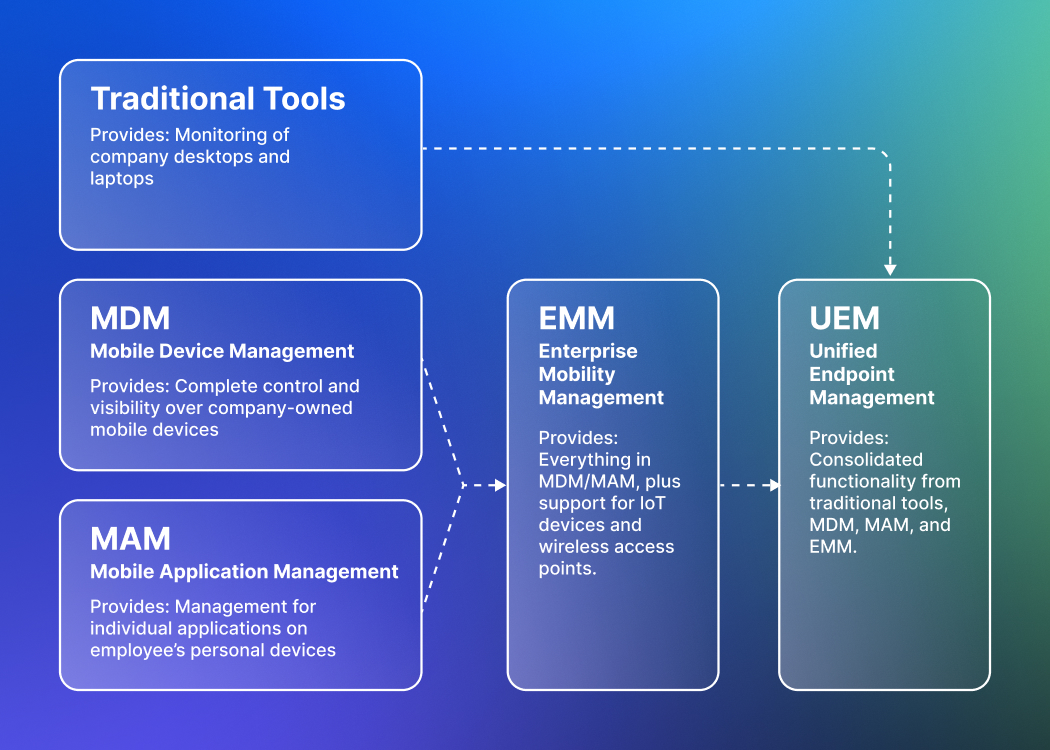
This brings us to the logical conclusion of this journey: Unified endpoint management. By now, you’ve probably worked out where this is going; UEM combines all of your endpoint devices into one place. It fills the last remaining gap in EMM products by consolidating these developments and adding the support to manage traditional laptops and desktop devices.
The 7 Best Unified Endpoint Management Solutions: Pros, Cons, and Reviews
So, long story short, effective unified endpoint management tools should offer you a simpler, cheaper, and less confusing way to manage all the endpoints in your IT environment. But to do that, you need to find the right product for your organization.
Here are seven options to choose from:
1. Heimdal®
It has been a very good tool for detecting endpoint threats and preventing lateral movement at the early stages. The user interface is intuitive and easy to use. There are frequent updates and patches to keep the tool updated.
Heimdal® User Review, via G2
Well we weren’t exactly going to miss ourselves off the list, were we?
In all seriousness, there are plenty of great endpoint management solutions on this list. But in our humble opinion, Heimdal® is the best of the bunch – for one clear reason that we’ll get into below.
But first, here’s a look at what’s on offer in our UEM module:
- Mobile device management – Our MDM functionality allows you to remotely locate, wipe, and lock devices.
- Zero trust execution prevention – This ensures that unknown or untrusted applications cannot be executed, creating an extra layer of defense if they pass through the initial scans.
- Ransomware protection – Our ransomware encryption protection product kills and stops ransomware outbreaks by detecting the processes that launch file encryption. It works alongside any antivirus to track attackers and eliminate attacks – even on mobile devices.
- Endpoint detection – Identify all endpoints in your environment, including disused and unknown accounts.
- Extended threat protection – Collect real-time information on user activity so you can effectively detect and respond to threats as they’re happening.
- A unified approach – Heimdal combines unique brute-force attack firewall detection, 4-layer next-generation antivirus, MDM, zero trust, and an XTP engine. Usually, this functionality is only available through separate products – and this unified approach is key to Heimdal’s unique success.
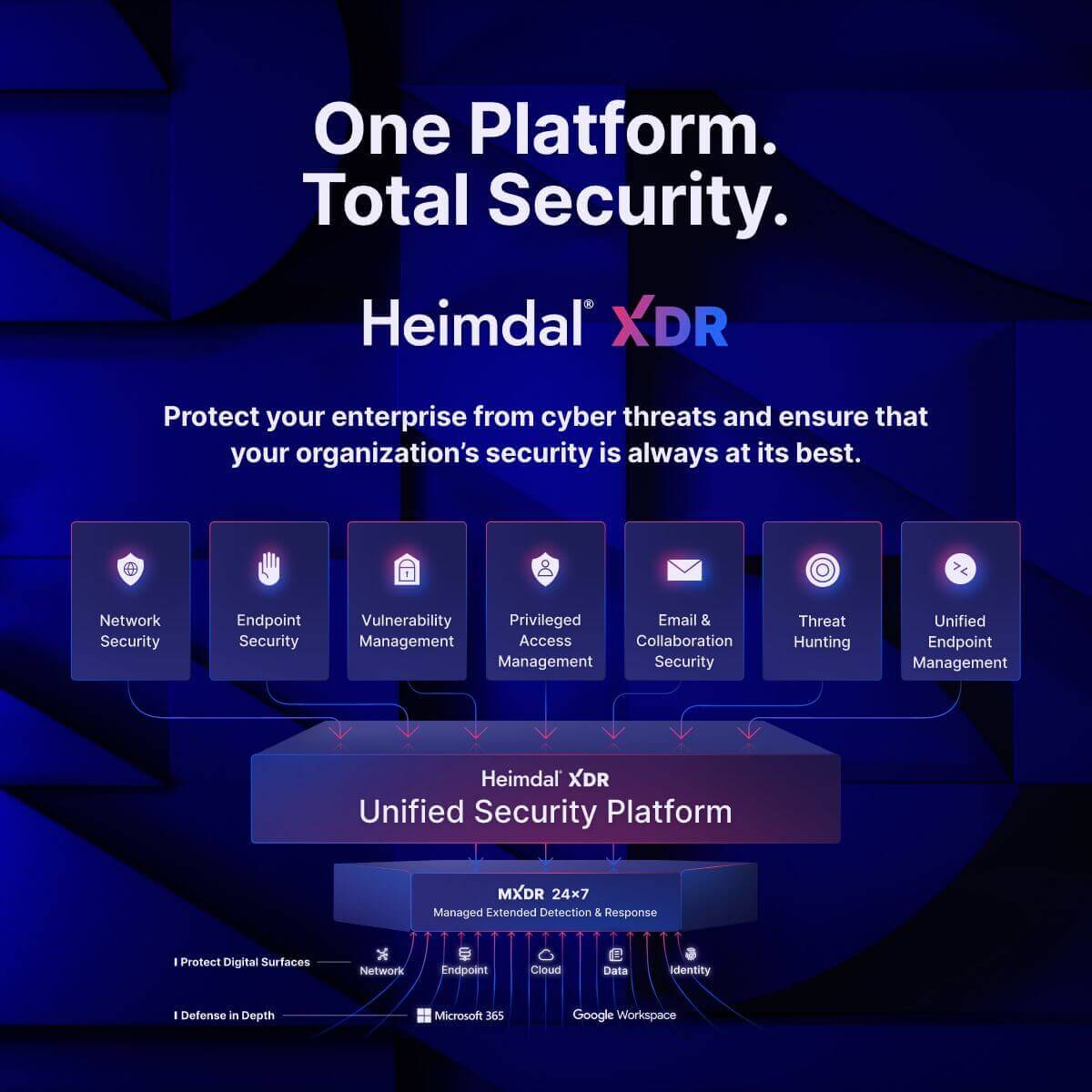
This last point sums up the main reason why Heimdal is (in our humble opinion) the best endpoint management software available: It’s not just a UEM.
There are plenty of other great options on this list, but they all share one key limitation: They’re designed to do one specific job and can’t act as a one-stop shop for all your cybersecurity needs.
With Heimdal, you get a single, unified cybersecurity base, with UEM functionality being available as part of a much wider solution. Here’s what that involves:
- Threat Prevention – A dynamic DNS traffic-filtering solution protects your IT environment from malware, ransomware, and other malicious code.
- Next-gen endpoint antivirus – Heimdal Security’s unique intelligence platform features four layers of antivirus detection, helping you identify and mitigate the most complex threats.
- Patch and asset management – Automated patching allows you to keep your apps and software up-to-date without manually monitoring or updating. This helps deliver better security with less effort.
- Privileged access management – Heimdal is the only PAM solution available that can automatically de-escalate user rights when threats are detected. This helps eliminate creepers and increase your overall access hygiene, without hours of manual effort.
- Network security – A seamless layer of AI-powered protection will allow you to detect and prevent advanced incoming threats. Secure all user devices regardless of their origin in one integrated window.
Together, these features form a single, unified approach to cybersecurity. That means you can eliminate silos, overlapping licenses, rising costs, and confusion. All this helps create a more efficient, effective, and watertight approach to cybersecurity that reduces stress for you and creates it for the hackers.
2. IBM Security: MaaS360

IBM almost certainly won’t need any introduction; it’s one of the most well-recognized tech companies in business. The flagship UEM software product is called MaaS360; a cloud-based solution.
Features include single sign-on, app-level tunneling, containerization, mobile application management, and more.
Pros:
It has been a very good tool for detecting endpoint threats and preventing lateral movement at the early stages. The user interface is intuitive and easy to use. There are frequent updates and patches to keep the tool updated.
MaaS360 User Review, via G2
- Robust security features: MaaS360 provides an effective and robust set of security tools, which easily compete with the most advanced products in the market.
- Customized reporting: Admins can create customized reports to monitor both application and device usage data. This helps them configure, validate, and test different policies to improve overall device security.
- Good support: The support is also extensive; Maas360 monitors and secures devices across Apple iOS, macOS, iPadOS, Google Android, ChromeOS, Microsoft Windows, and various IoT and wearable devices.
- Mobile application management: The tool also offers native MAM support and the ability for admins to containerize work apps on users’ personal devices.
Cons:
It is a little bit complex and can take time to learn how to use. The cost is also more than other solutions.
MaaS360 User Review, via G2
- No on-premises support: Maas360 is only available as a SaaS product, meaning it’s not suitable for organizations with on-premises or hybrid requirements.
- Cost: IBM is consistently rated as one of the most expensive products on the market by user reviews. This generally tracks with the company’s reputation as an advanced security provider for large enterprises.
- Learning curve: Reviews have also mentioned that the platform is complex for new users to understand and use.
Pricing:
Unlike most security providers on this list, IBM publishes its headline pricing rates. The product is available in four separate packages, each priced per device, per month (pd/pm).
- complEssentials: $4 pd/pm
- Deluxe: $5 pd/pm
- Premier: $6.25 pd/pm
- Enterprise: $9 pd/pm
Customers appreciate the clarity and consistency of these prices, even though they still exceed most competitors.
Reviews:
3. Ivanti: Ivanti UEM

Ivanti provides a range of IT tools for some of the world’s largest enterprises. The company was formed in 2017 as a merger between Landesk and Heat Software.
As the name would suggest, Ivanti UEM is the provider’s unified endpoint management product, offering effective security functionality across many devices. In terms of support, the product monitors devices across Apple iOS and macOS, Google Android, ChromeOS, Microsoft Windows, and Linux.
Ivanti’s features include containerization, MAM, role-based access controls, and more. However, some of these products are only available via specific add-ons.
Its ability to automate tasks, provide proactive security measures, and offer insights through analytics makes it a robust solution for IT management.
Ivanti UEM User Review, via G2
- Comprehensive security coverage: Ivanti’s UEM features compare well to other providers on this list. It has wide support, native MAM capabilities, automated patching for 3rd party apps, containerization capabilities, and more.
- User-friendly interface: User reviews also praise the product for its straightforward and simple user interface.
- Automation: The product includes wide automation potential. This includes automated updates, operating system migration, 3rd-party app patching, and more.
Cons:
“The dashboard sometimes lags navigating through important functions, which may require manual intervention to resume.
Ivanti UEM User Review, via G2
- Multiple products: To get the full suite of functionality, customers have to purchase several add-ons. These include Ivanti Neuros for UEM Premium, Ivanti UEM On-Prem, On-Prem Premium, and On-Prem Premium with VPN.
- Complex setup: Users mention that setting up the product can be complex and time-consuming and that training is often required for people to use it effectively.
- Performance issues: Ivanti also experiences some performance issues, such as dashboards or pages lagging during navigation.
Pricing:
Like most cybersecurity providers, Ivanti does not publish pricing information. However, user reviews suggest that it’s reasonably priced and about average for the market.
There is however a significant difference in the pricing model – all Ivanti UEM customers are charged on a pay-as-you-go basis, rather than a per device or user plan. Some organizations may prefer this model since it creates a lower barrier to entry, and doesn’t involve a fixed agreement. Others may find the fluctuating prices less appealing than a more predictable and scalable model.
Reviews:
4. Microsoft Intune
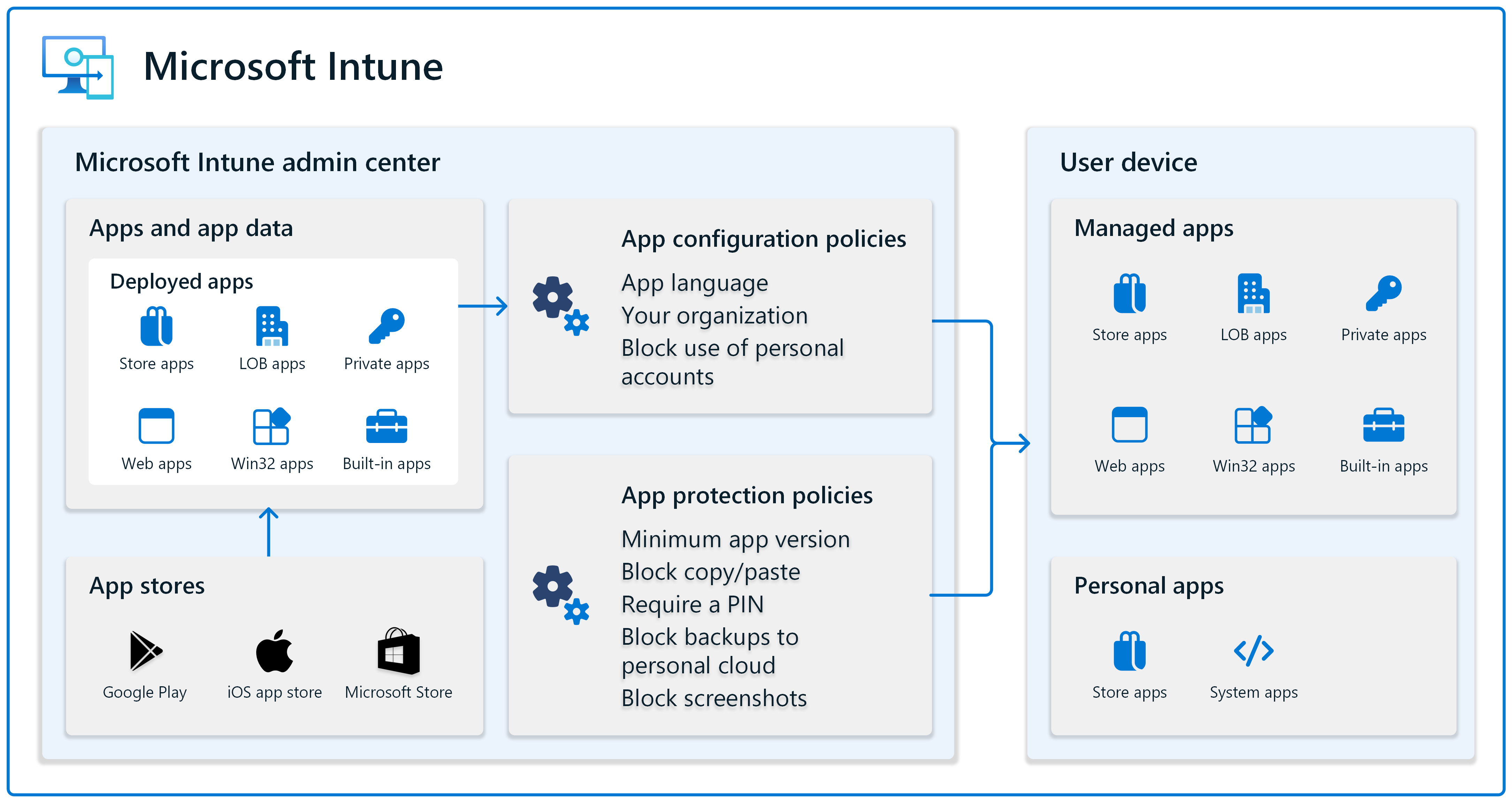
Another provider you’ll certainly be aware of; Microsoft Intune is another popular endpoint monitoring software product. And for many organizations, it’s also the default setting – since it often comes packaged with wider Microsoft 365 licenses. Many of the other tools on this list also integrate with Microsoft Intune, since organizations often use it alongside 3rd-party cybersecurity products.
Intune features an impressive range of UEM tools, including the ability to synchronize devices, reset passcodes, perform remote wipes, implement role-based access controls, and more.
In terms of support, you can expect to use Intune across several devices and OSs – not just Windows. This includes Google ChromeOS, Android, OEMConfig, AOSP, Microsoft Windows, and some Linux deployments. While not as extensive as some products on this list, it’s enough to cover the needs of most organizations.
Pros:
A powerful and comprehensive tool for managing devices and ensuring security and compliance.
Microsoft Intune User Review, via G2
- Microsoft-native: Microsoft Intune integrates organically into the wider Microsoft ecosystem. It works particularly well with the Microsoft Active Directory, recognizing the users and groups that are configured elsewhere in Windows products.
- Hosting: Intune is available for cloud, on-premises, and hybrid deployments – making it particularly useful for organizations with complex IT environments.
- Integrations: The product also integrates with a whole range of 3rd-party apps, including app store, custom apps, built-in apps, and web apps.
Cons:
Documentation can be improved so it can be used easily. Some patch updates are also hectic for users – which can be improved.
Microsoft Intune User Review, via G2
- Complex pricing: Like all Microsoft products, Intune has many conflicting and overlapping licensing models. It’s also included in some wider Microsoft 365 packages, meaning it can be unclear whether customers already have the features, and which add-ons they’ll need if not.
- Documentation and error messages: Users report that the documentation can be convoluted and difficult to use.
- Misconfiguration: Intune is easier to accidentally misconfigure than some other products on this list. Combined with the limited documentation, this can make it a difficult product to effectively use.
Pricing:
Microsoft does not publish headline pricing rates for Intune. Like most products, it is subscription-based, and there are three standard plans for customers to choose from:
- Plan 1
- Plan 2
- Intune Suite
Intune is also bundled together with a range of Microsoft 365 licenses, including E3, E5, EM+S, and others. It is possible to purchase licenses direct from Microsoft, though businesses are usually encouraged to engage a Microsoft Partner business instead, who will charge differing rates for managed support on top of the the standard license charge.
Reviews:
5. Omnissa: Workspace One (FKA VMware)

Omnissa (fka VMware) is another leading IT provider with a diverse and varied product range. But here, the most relevant product is Workspace One, the unified endpoint management software offering.
At the center of VMWare’s product is a centralized dashboard that allows IT admins to manage devices of all shapes and sizes, including laptops, mobiles, rugged devices, and more.
The dashboard also shows endpoints that are compromised, unencrypted, or lacking passwords. This gives IT admins an effective birds-eye view of the endpoints in their environment and their associated vulnerabilities.
The main features of Workspace One include native MAM tools, containerization, automated patching of 3rd-party apps, and more.
Pros:
Workspace One supports various device types and operating systems, including iOS, Android, Windows, and macOS. This allows organizations to provide their employees with a flexible and diverse set of endpoints while maintaining high security and control.
Workspace One User Review, via G2
- Comprehensive device management: Workspace One supports a wide range of devices and operating systems, including Apple iOS, Google, Android, ChromeOS, Linux, Windows, and various rugged devices. This is particularly helpful for large companies with distributed teams and complex IT environments.
- Ease of use: Users generally note that the platform is intuitive and easy to use, despite the breadth of functionality and support.
- Effective remote access: VMWare UEM customers can enjoy extensive remote access capabilities, including the ability to remotely install and remove applications – as well as remote desktop access.
Cons:
Users need high internet bandwidth to access the content properly.
Workspace One User Review, via G2
- Cost: Workspace One is generally considered one of the more expensive products on the market.
- High bandwidth: Reviewers have also mentioned that the product requires a high internet bandwidth to perform at its best – which can be an issue for those without decent internet connectivity. Other users mentioned that the app drains battery life on mobile devices quite quickly.
- Technical issues: Some other technical issues around installations have also been noted. The installation, in particular, can be slow and may sometimes freeze.
Pricing:
VMWare doesn’t publish pricing information, though reviewers generally agree that it’s among the most expensive products on the market.
Reviews:
6. ManageEngine Endpoint Central
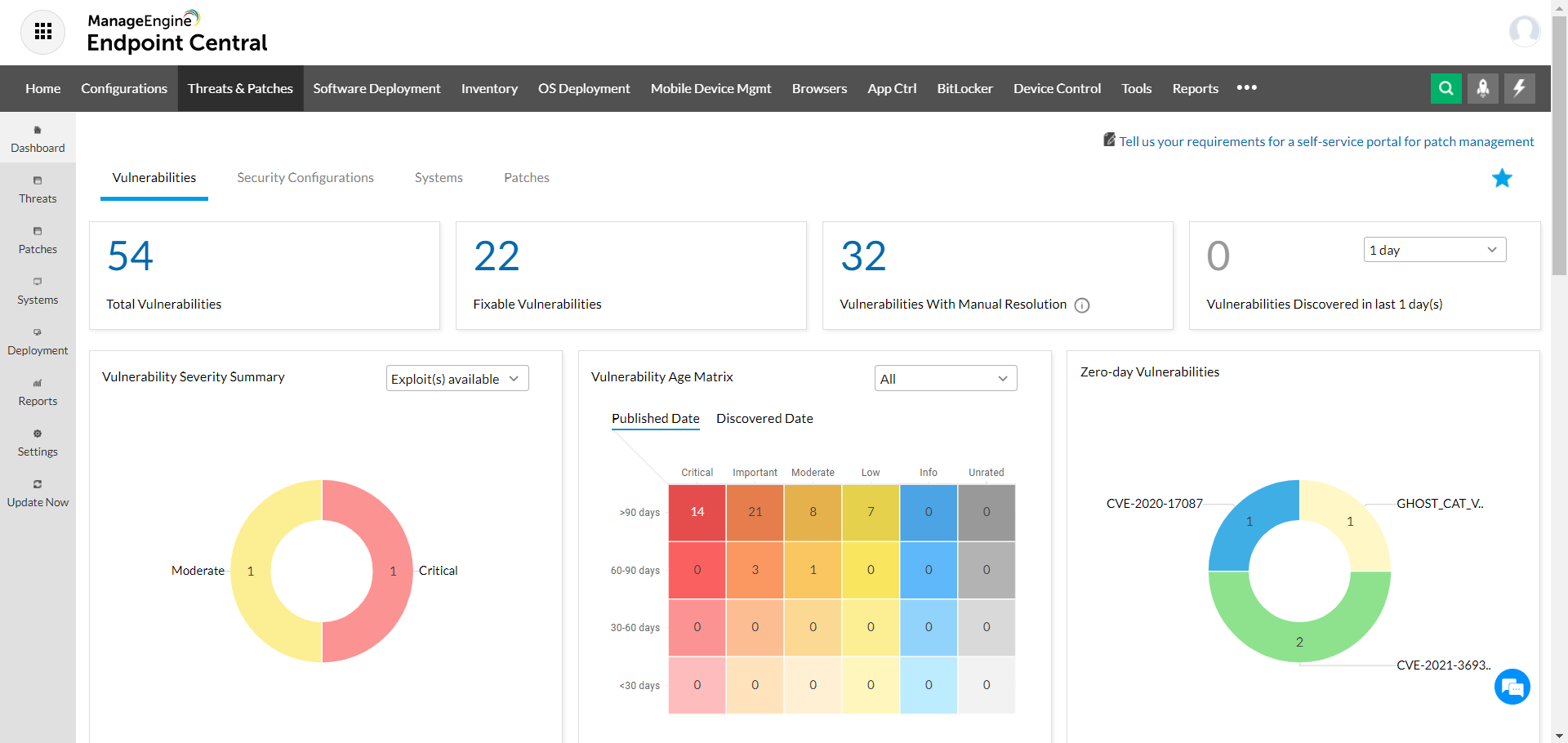
Endpoint Central aims to be an ‘all-in-one’ endpoint platform that brings a whole range of devices together across cloud, on-premises, and hybrid environments.
One of the clearest benefits of this product is the breadth of support. Indeed, clients can monitor and secure devices as diverse as servers, laptops, desktops, smartphones, tablets, and more.
Endpoint Central also features a respectable featureset, including asset management, endpoint activity reports, usage restrictions, remote device takeover, and the ability to remotely manage USB devices.
Pros:
With this product, we have enhanced the quality of work performed as installation procedures are now consistently executed, without the risk of human variables. We have reduced the time spent on repetitive tasks with low added value.
Endpoint Central One user review, via G2
- Automations: The product features a wide and effective set of automations, including the ability to deploy software and update patches.
- Wide support: The product has some of the widest support in the market, including Apple iOS, iPadOS, macOS, tvOS, Google ChromeOS, Android, Android OEMConfig, AOSP, Linux, and Windows. However, a word of caution; feature parity is not the same across all operating systems (see below).
Cons:
My main issue is that there’s so much in the product that I’m overwhelmed.
Endpoint Central One user review, via G2
- Complexity: The large range of features and support unfortunately makes the product more difficult to use than some on this list. It can take a while for users to understand how to use the product to its best potential.
- Confusing pricing: Endpoint Central offers different prices depending on whether customers pay an annual, monthly, or perpetual license. There are also differing rates depending on the number of servers or technicians being used, as well as having four separate tiers of functionality: professional, enterprise, UEM, and security.
- Limited Mac and Linux functionality: Despite the wide functionality, the product is much more effective in Windows environments. The feature set across Mac and Linux is more limited and the product generally works better when connected to the Microsoft Active Directory (AD).
- On-prem updates: Some users have also mentioned limitations with the on-premises version of the product, particularly when it comes to updates.
Pricing:
ManageEngine offers a free trial where users can enjoy some functionality for up to 25 devices. They also publish the headline pricing for the paid tier on their website – though this is complex with many different factors affecting the final price. Therefore, it’s difficult to offer a clear comparison with other products in this list.
Reviews:
7. Scalefusion
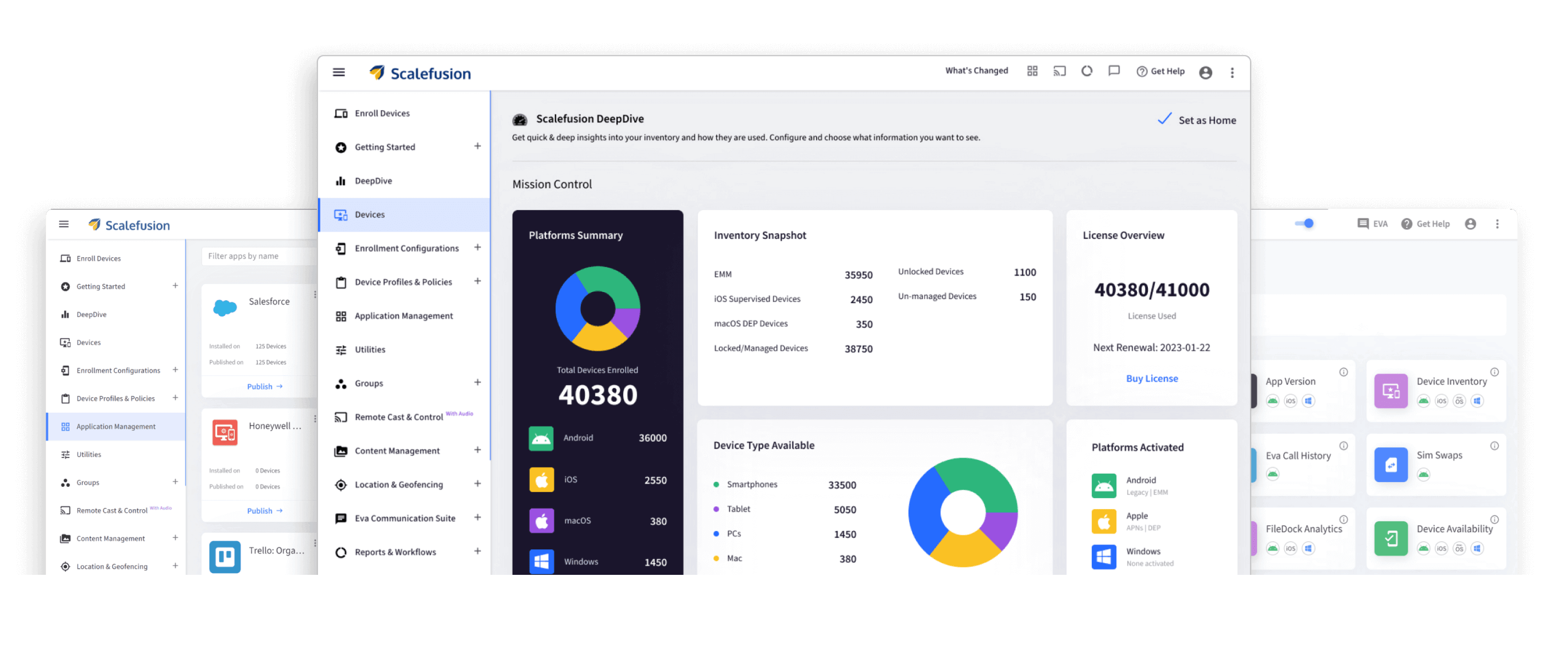
If you take a look at Scalefusion’s marketing material, you’ll see that ease of use sits at the center of their messaging. This seems to chime with users’ experience, who regularly praise it as simpler and more ergonomic than many competitors on this list.
Scalefusion also has a range of features designed to effectively manage remote devices. This includes role-based access for admins, password policy configuration, screen capture blocking, and more. It also features support for Apple iOS, iPad OS, macOS, Google Android, Android OEMConfig, Windows, and some Linux distributions.
Pros:
The interface is sleek and user-friendly, making it easy to deploy apps and manage settings across multiple devices.
Scalefusion user review, via G2
- Ease of use: Customers generally note that the product is straightforward and easy to use – in contrast to many others on this list. It also features extensive documentation and effective support.
- Wide hosting options: Scalefusion is available across on-premises, cloud, and hybrid systems, providing diverse options for complex IT environments.
Cons:
It shows too many notifications about what is being controlled – which is very disturbing and intimidating for the user. There is the possibility to disable these notifications – but then it disables every notification of any app.
Scalefusion user review, via G2
- No containerization: Unlike most of its competitors, Scalefusion doesn’t offer containerization functionality. This makes it harder for organizations to achieve secure app management on end-user devices since they can’t be separated from users’ personal apps.
- Support: Scalefusion’s support is decent, but not as extensive as others on this list. Notably, not all Linux deployments are supported, and some reviewers have mentioned the lack of ChromeOS support as an issue.
- Customization: Reviewers have also noted challenges in configuring and customizing the platform. This is particularly the case around notifications, which can be overly intrusive and difficult to switch off.
Pricing:
Scalefusion has four packages available, all priced on a standard per device/per month basis. However, it’s important to know that all billing is charged annually, despite the monthly price being quoted. All prices are published on the website; custom options and free trials are also available.
- Essentials: $2 pd/pm
- Growth: $3.50 pd/pm
- Business: $5 pd/pm
- Enterprise: $6 pd/pm
Reviews:
Heimdal®: More Than Just a UEM
The goal of the endpoint monitoring tools on this list is to offer a single dashboard through which to manage all of your endpoints and devices. The logic is to consolidate overlapping products like MAM, MDM, and EMM into one unified solution.
But there’s one issue most of the products on this list have in common. While there’s plenty of effective UEM functionality here – these products can’t manage privileged access management, threat detection, or other cybersecurity protections. By design, they’re siloed, meaning you’re still going to need separate tools and licenses to create a complete and layered cybersecurity defense.
Heimdal®’s unique approach is to eliminate these siloes. Why have a single platform to manage devices when you can have one license that covers all of your cybersecurity needs?
Our consolidated approach helps customers reduce subscriptions, confusion, and costs, without sacrificing the leading UEM functionality you need to stay safe.
FAQs:
What is a UEM solution?
A unified endpoint management (UEM) solution aims to give IT admins a single dashboard through which to manage all company devices, including laptops, computers, smartphones, tablets, IoT devices, and much more. It consolidates functionality from tools like mobile application management, mobile device management, and more into a single product.
Is Intune an MDM or UEM?
Microsoft’s Intune product is a unified endpoint management tool. It is popular for its integration with Windows and inclusion in many organizations’ existing Microsoft 365 packages. It includes mobile device management (MDM) functionality as well as tools to remotely manage applications and other devices.
How is MDM different than UEM?
Mobile device management (MDM) is designed to give IT teams complete control and visibility over corporate-owned mobile devices. But this policy isn’t effective when employees want to use their own personal devices. Instead, mobile application management (MAM) evolved to give IT teams control over specific apps on personal devices, using containerization.
Unified endpoint management combines both of these features into one platform and includes support for other devices, like traditional desktops, laptops, IoT devices, rugged devices, and more.






